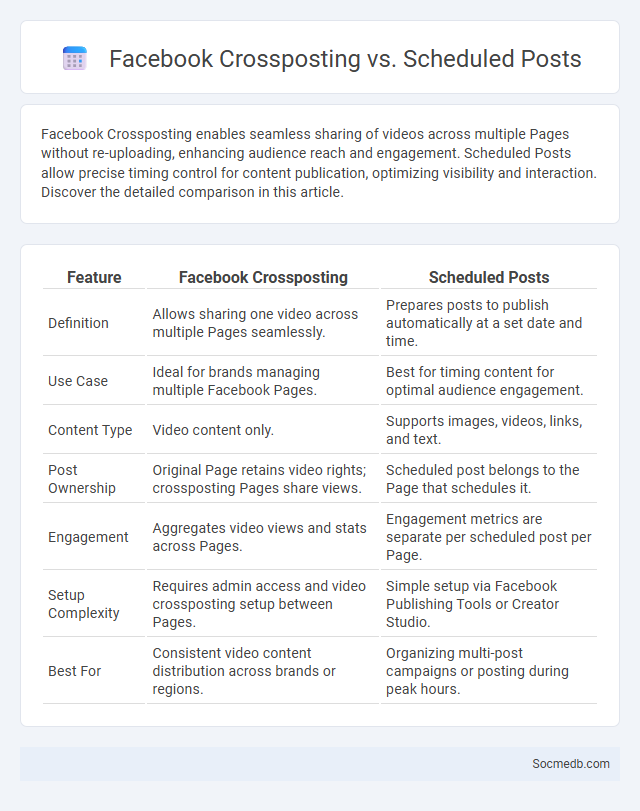
Photo illustration: Facebook Crossposting vs Scheduled Posts
Facebook Crossposting enables seamless sharing of videos across multiple Pages without re-uploading, enhancing audience reach and engagement. Scheduled Posts allow precise timing control for content publication, optimizing visibility and interaction. Discover the detailed comparison in this article.
Table of Comparison
| Feature | Facebook Crossposting | Scheduled Posts |
|---|---|---|
| Definition | Allows sharing one video across multiple Pages seamlessly. | Prepares posts to publish automatically at a set date and time. |
| Use Case | Ideal for brands managing multiple Facebook Pages. | Best for timing content for optimal audience engagement. |
| Content Type | Video content only. | Supports images, videos, links, and text. |
| Post Ownership | Original Page retains video rights; crossposting Pages share views. | Scheduled post belongs to the Page that schedules it. |
| Engagement | Aggregates video views and stats across Pages. | Engagement metrics are separate per scheduled post per Page. |
| Setup Complexity | Requires admin access and video crossposting setup between Pages. | Simple setup via Facebook Publishing Tools or Creator Studio. |
| Best For | Consistent video content distribution across brands or regions. | Organizing multi-post campaigns or posting during peak hours. |
Introduction to Facebook Crossposting and Scheduled Posts
Facebook Crossposting enables seamless content sharing across multiple Pages without duplicating uploads, increasing reach and engagement efficiency. Scheduled Posts allow precise timing of content publication, optimizing audience interaction by targeting peak activity periods. Utilizing these tools enhances social media strategy, improves content management, and drives consistent audience engagement on Facebook.
Understanding Facebook Crossposting: Features and Benefits
Facebook crossposting enables content creators to share videos across multiple Pages without uploading duplicates, preserving engagement metrics and comments. This feature streamlines content distribution by maintaining video quality and audience insights, enhancing reach and interaction efficiency. Leveraging crossposting optimizes brand visibility while reducing administrative efforts in social media management.
What Are Scheduled Posts on Facebook?
Scheduled posts on Facebook allow you to plan and set specific times for your content to be published automatically. This feature helps you manage your social media calendar efficiently, ensuring consistent engagement and timely updates without manual posting. By using scheduled posts, you can optimize your reach and maintain a steady online presence tailored to Your audience's activity patterns.
Key Differences Between Crossposting and Scheduled Posts
Crossposting involves sharing the same content simultaneously across multiple social media platforms, maximizing reach and maintaining consistent messaging. Scheduled posts are pre-planned and queued content releases on individual platforms at specific times, allowing for optimal engagement based on audience activity data. The key difference lies in crossposting's simultaneous multi-platform distribution versus scheduled posts' timed, platform-specific content management.
When to Use Crossposting vs Scheduled Posts
Crossposting works best for sharing identical content across multiple social media platforms simultaneously to maximize reach and engagement without extra effort. Scheduled posts are ideal for planning content delivery at optimal times tailored to each platform's audience behavior, ensuring consistent activity and better time zone targeting. Brands should leverage crossposting for uniform campaigns and scheduled posts when customizing messages for diverse audiences across channels.
Best Practices for Crossposting on Facebook
Effective crossposting on Facebook involves optimizing content for audience engagement by tailoring posts to the platform's native features like Facebook Stories, Groups, and Pages. Using Facebook's native tools to schedule posts ensures timely publication and better reach, while maintaining consistent branding and messaging across platforms boosts credibility. Monitoring analytics helps refine strategies, determining which type of content generates the highest interaction and reach.
Scheduling Content: Tips for Maximizing Engagement
Scheduling content on social media platforms helps you maintain consistency and reach your target audience at peak times for maximum engagement. Utilizing tools like Buffer, Hootsuite, or Later enables you to plan and automate posts across multiple channels, ensuring timely delivery and reducing manual effort. Analyzing audience activity patterns and adjusting your posting schedule accordingly boosts visibility and interaction with your content.
Common Mistakes in Facebook Crossposting and Scheduling
Common mistakes in Facebook crossposting and scheduling include failing to tailor content for different audience segments, resulting in reduced engagement and reach. Overusing automated scheduling tools can lead to poorly timed posts that miss peak user activity periods, diminishing visibility. Neglecting to monitor post performance and adjust strategies based on analytics prevents optimization of content effectiveness across multiple pages.
Analytics: Measuring Success for Each Content Strategy
Social media analytics provide detailed insights into how your content performs across platforms, measuring engagement metrics such as likes, shares, comments, and click-through rates. By analyzing these data points, you can identify which content strategies drive the highest user interaction and adjust your approach to maximize reach and ROI. Understanding audience behavior through tools like Google Analytics, Facebook Insights, and Instagram Analytics allows you to tailor your campaigns effectively and track success in real-time.
Conclusion: Choosing the Right Facebook Posting Method
Selecting the right Facebook posting method depends on your content goals, target audience, and engagement strategy to maximize reach and interaction. Scheduling posts during peak activity hours increases visibility, while using varied formats like images, videos, and links keeps your audience engaged. Optimizing your Facebook posting approach ensures your content stands out and effectively supports your brand's growth.
 socmedb.com
socmedb.com